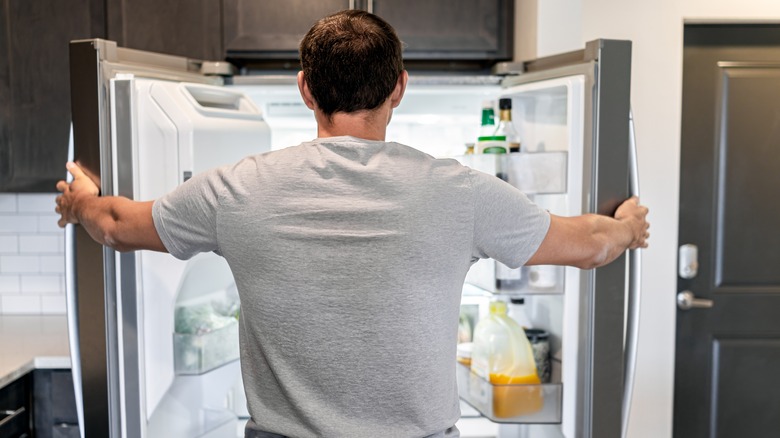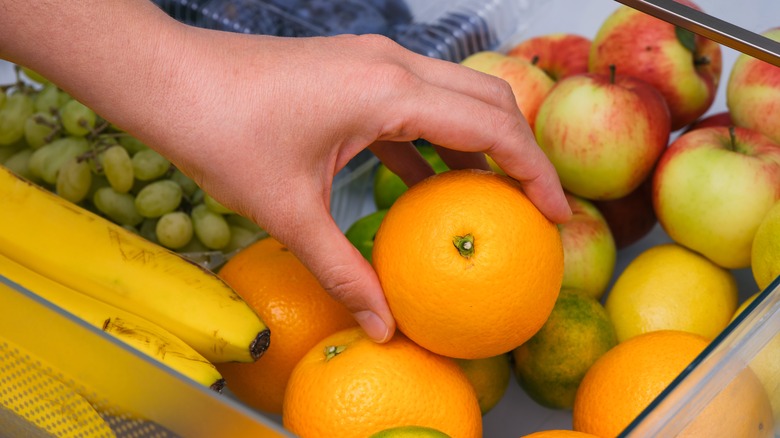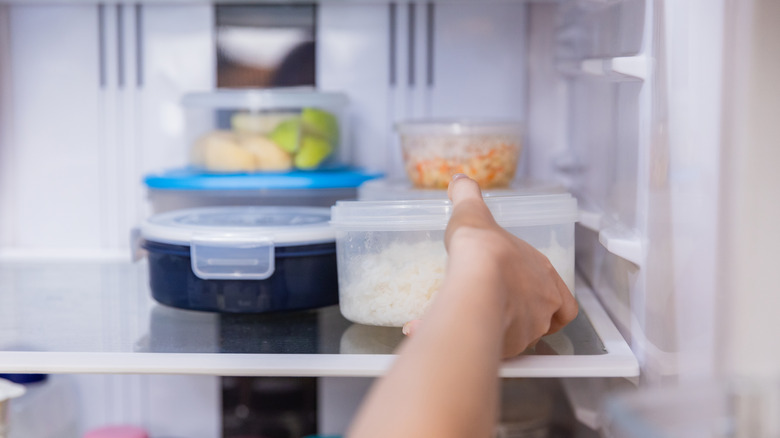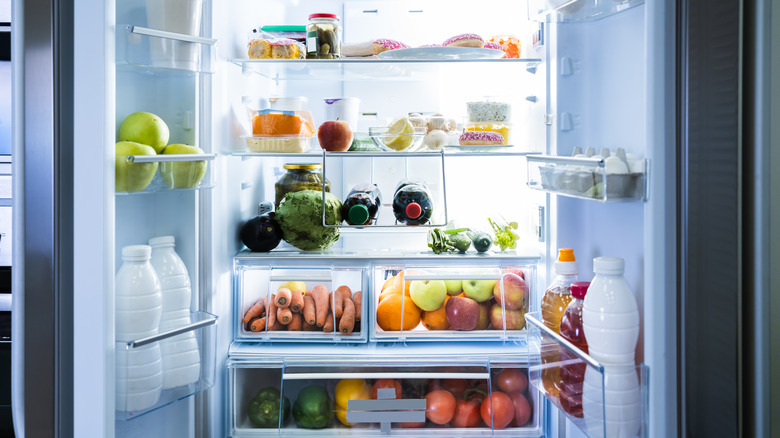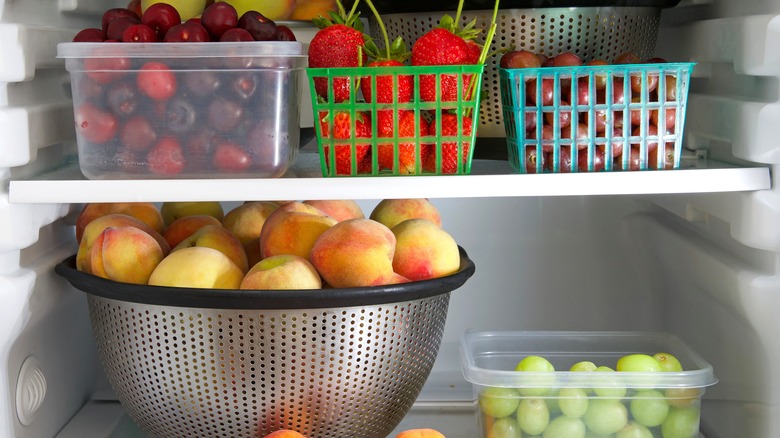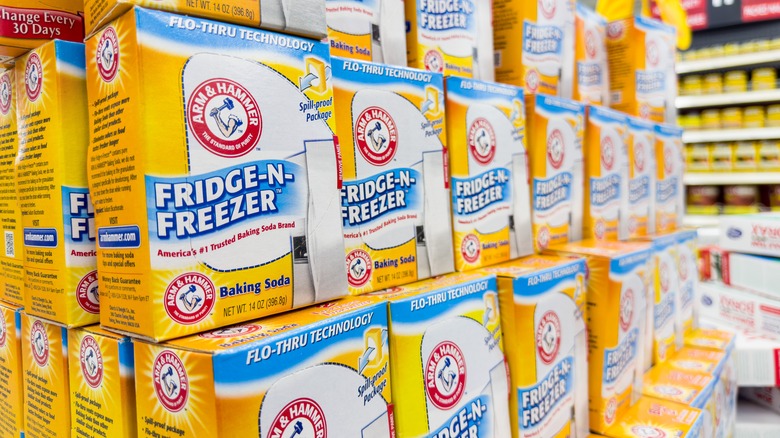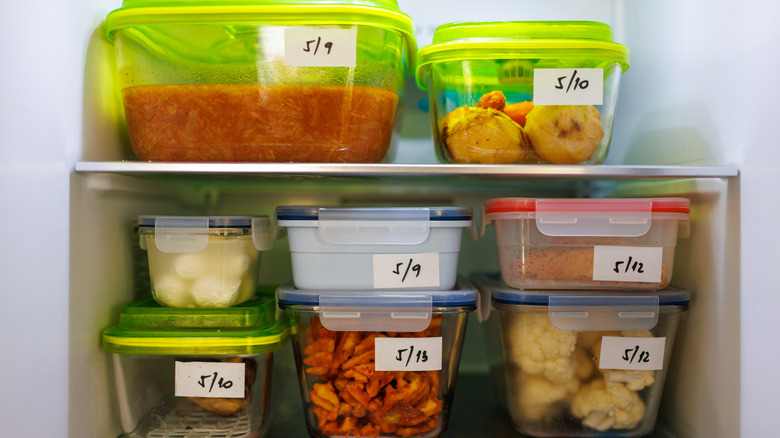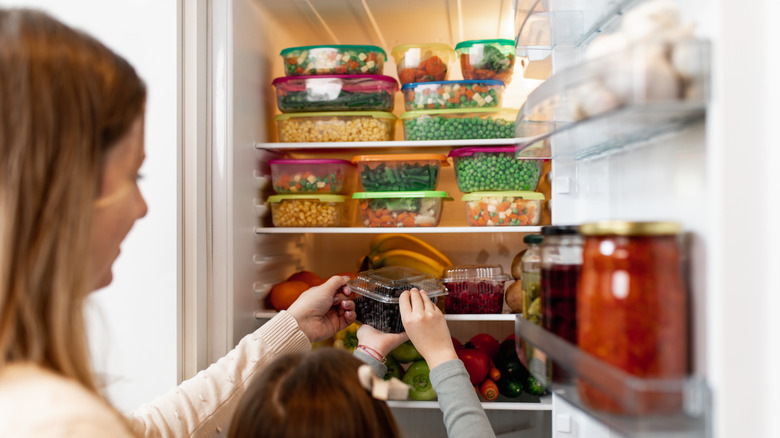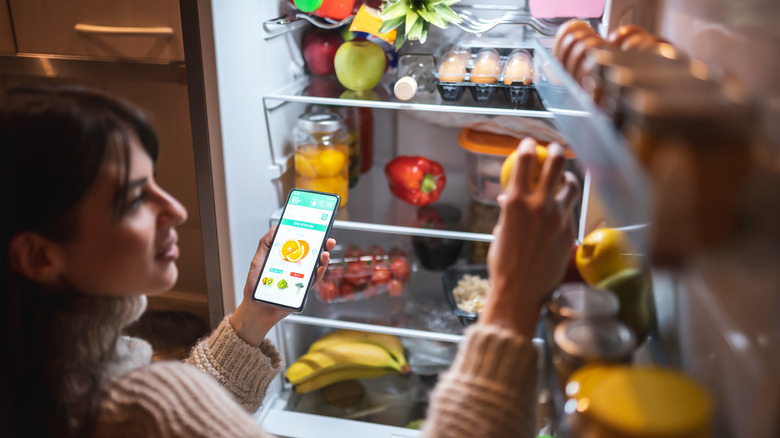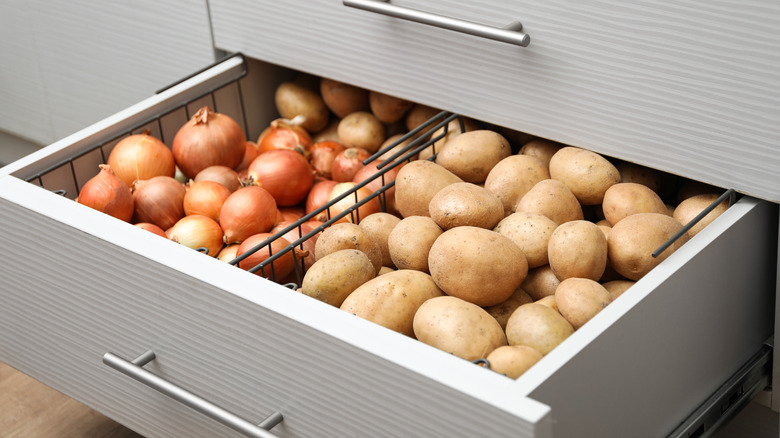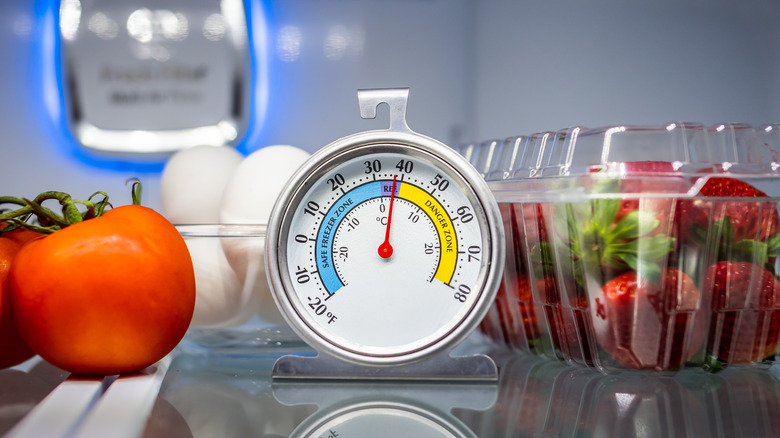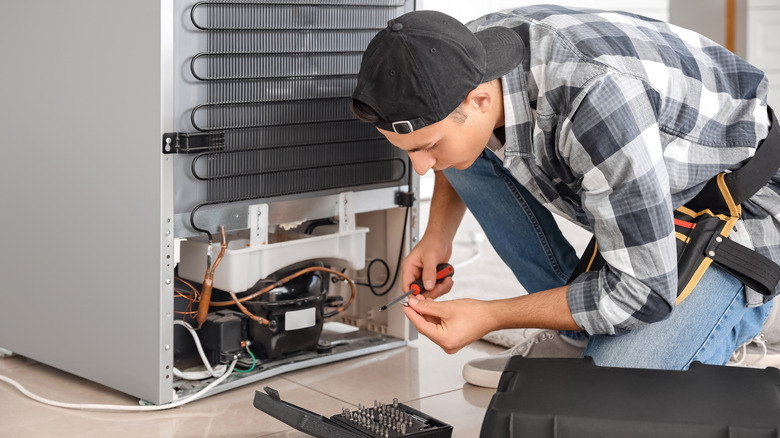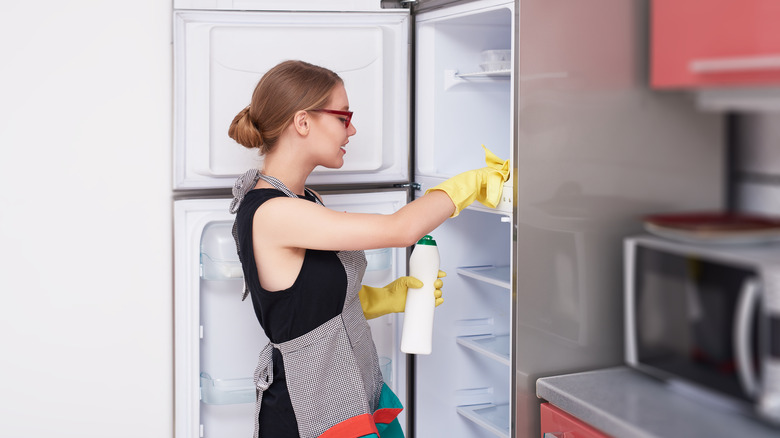13 Tidy Tips To Achieve A Cleaner Refrigerator
Do you find yourself digging around in your refrigerator for what feels like forever, only to discover the food you were looking for is expired? This is a common problem that many people face, especially if they enjoy cooking at home. Keeping a clean and tidy fridge is essential to get the most out of your groceries and leftovers before they go bad.
A disorganized fridge makes it difficult to see what you have in stock, which can lead to forgetting which foods you've purchased. And if you've forgotten that you've purchased something (or simply can't see it because it's hidden), you are unlikely to use it before it goes bad. This often leads to food waste — and let's be honest, that's not good for the environment or your wallet. Additionally, rotten foods can cause mold and mildew in your refrigerator, which can spread to other foods, leading them to rot faster.
Keeping your refrigerator organized, sanitized, and properly maintained is a great way to reduce waste, save money, and make cooking at home more efficient and safe. Let's take a look at some of the best ways you can keep your refrigerator clean.
Use drawer liners
Mushy, rotten produce causes a huge mess in your refrigerator drawers. And it can be a hassle to pull out your refrigerator drawers to begin with — furthermore, trying to clean them in the sink is unwieldy and can lead to water and soap splashing everywhere. Even the most dedicated fruit and vegetable lovers have produce go bad from time to time, so it's best to prepare to make clean up easier when it happens.
One excellent way to do this is by using drawer liners. Refrigerator drawer liners are thin sheets of padding that generally come in standard sizes, but can also be cut with scissors to fit your specific drawer shape. You place them in the bottom of your refrigerator drawers and store produce, meats, or other foods on top of them. This way, whether a meat package starts to leak, or bag of spinach goes bad, any liquids will be absorbed by the liner, rather than pooling in the bottom of your drawer. When the liner has absorbed something, you can simply remove the items from the drawer, throw away the liner, wipe the drawer with a disinfecting wipe, and then put in a new liner. Even if there are no leaks in your refrigerator, drawer liners can also help keep your produce fresh by absorbing condensation.
Use proper storage containers
Properly storing leftovers from your meals, as well as any opened raw or uncooked foods, is a key way to keep your refrigerator looking and smelling clean. In order to eliminate contaminates getting into your food and smells from your food escaping, airtight storage is the best option. Whether you use zip top bags, plastic or glass boxes (or bowls) with lids that have rubber seals, airtight storage will keep food and odors locked in and bacteria locked out.
You may already be accustomed to placing your meal leftovers in these containers, but partially used packages of food from the store are important to monitor as well. Unless the container from the store specifies that it is resealable, it's best to transfer it to a bag, box or bowl that you know for certain has an airtight seal. This will help keep all of your food fresh and for longer, because even if one thing in your refrigerator starts to go bad, the mold and bacteria cannot pass through the airtight seal and transfer to other foods in different containers.
Create zones
Categorizing your fridge into particular zones is a great way to make foods easier to find and help them stay fresh longer. Additionally, keeping foods within their own zones can help prevent cross-contamination. Your refrigerator can be divided into these five major zones: upper shelves, middle shelves, lower shelves, drawers, and doors. From there you can create smaller zones for like items to stay together.
For example, your upper shelves should contain items that are at relatively low risk of spoiling or won't be there for very long — leftovers or snacks come to mind. You may want to divide your top shelves so that snacks are on one side all next to each other and leftovers stay on the other side. Middle shelves should contain items like eggs and deli meat that are only at moderate risk of spoiling. The bottom shelf should hold dairy products — milk and yogurt can spoil easily so this zone is usually the coldest.
What about your drawers? These are great for meats and veggies. And the rails along the door are great for things that don't spoil easily — condiments, alcohol, and other beverages that don't need to be refrigerated but you prefer to drink cold. This method will keep your foods at the appropriate temperature, and the organization will make them easy to reach. Since meats and veggies are on the bottom, it will prevent raw meat juice and rotten vegetables from leaking onto other foods.
Bins will keep food organized
Translucent plastic or glass bins are a great way to take your zone organization to the next level. You can give each of your shelf zones multiple sub-zones by employing the use of bins. Bins can also make it easier for all members of a household to find what they are looking for. For example, creating a bin of snack foods for children and placing a label on the bin that says "snacks" can make after-school snacking easier and faster.
Bins are also helpful if you have multiple single serve packages of something — yogurt, for instance. Putting several single serve containers of yogurt into a clear bin makes it easier to keep them together, and to pull them out easily — and when making a grocery list, it's also visible to see how many you have left. And clear bins serve as an effective barrier — if something leaks or spills, it is much easier to remove and clean a small plastic bin than an entire refrigerator shelf.
Baking soda will eliminate odors
Whether you've left your veggies in the drawer a little too long or you forget to properly close the airtight container of leftovers, it's easy for odors to find their way into the air inside your fridge. But don't worry — there's a simple solution that can be found at any grocery store: baking soda.
How does baking soda work? When food releases unpleasant smells in your refrigerator, it is generally caused by mold and bacteria breaking down the food, during which small food particles are released into the air. The baking soda works by attracting these molecules and giving them something to bond to, which pulls them out of the air. And your refrigerator will become stink-free.
To make sure your refrigerator stays fresh, replace your baking soda every one to three months, depending on the size of the baking soda container. It's also essential to remember that this process means the baking soda has absorbed rotten food particles — and because of this, it is extremely important to never use baking soda that you have kept in the refrigerator for any actual baking or other eating-related purposes.
Label items with open dates
One of the easiest ways to make sure that you are adhering to food safety guidelines in your refrigerator is by labeling food containers with dates. Most foods and drinks that make their way into your fridge have a standard number of days they can stay in there before consuming them poses the risk of food poisoning. To make sure you don't lose track of how long items have been in your refrigerator, you can use a permanent marker to easily label them.
For reusable containers with leftovers or meal-prepped food in them, place a peel and stick label on the container so you can clearly write with a marker the date you put it in the fridge. Additionally, many items that stay in their manufacturer's containers in the refrigerator may say, "Use within 10 days of opening" on the side. For items like this, look for a spot on the container's label with some empty space and write down the date you opened it. This way, you will always know how much time has passed since your food was exposed to air, so you can ensure it is within the timeframe for safe consumption.
First in, first out
Nobody wants to run out of their favorite foods and drinks. Keeping your refrigerator well stocked can help ensure this doesn't happen. However, it may mean buying another container of food or, say, milk, before the one you already have is empty. To help keep you and other members of your household from opening the new container before the previous one is empty, you can use the FIFO or "first in, first out" method of organizing your refrigerator.
FIFO makes sure that older products — especially ones that have already been opened or are quickly approaching expiration dates — are put in front of your refrigerator so that they are the first thing you will grab. Newer and unopened items should be placed behind them to be used only after the items in front are finished or thrown away. The FIFO method is a great way to practice food safety (and achieve a cleaner refrigerator) because it makes items more likely to be used before they expire. It's also a productive way to save money because it keeps food fresher longer.
Don't overfill your fridge
When life gets busy, it's easy for items to start piling up in your refrigerator. While going through everything in your fridge may seem daunting, it is essential to make sure that you're not overfilling it. Stuffing your refrigerator can quickly lead to food safety issues for two reasons.
The first and probably more obvious reason is that overfilling your refrigerator makes it difficult to see what you have. Items become hidden behind each other — before you know it, there are foods that have been pushed to the back of your refrigerator that start expiring and growing mold. This can cause smelly odors, spread mold to other foods, and become dangerous to your health. The other key reason to not overfill your fridge is to maintain proper temperature regulation. If you've ever been in a room that has an air conditioner but is filled with people, you know that it can still be quite warm.
The same can be true about your refrigerator. If it's too packed with food, the cold air cannot circulate properly, which means the item temps won't be kept at the temperature you set. Food isn't properly preserved if your refrigerator is not at the proper temperature — this can (and often will) make food unsafe to eat.
Conduct routine inventory checks
Once you've come up with systems for categorizing and containing the foods and drinks in your refrigerator, it should be easy to keep track of what is going in and out of your fridge. After that, it is important to stick to your systems and routinely go through everything so your refrigerator stays clean and organized. Some excellent ways to keep track of everything include taking stock of what items you need to replace at the grocery store each week — along with a monthly clean out to sanitize shelves and double check that all expired items have been removed.
Whatever frequency works best for you and your household, routine fridge inventory checks are key to reducing food waste, ensuring food safety, making sure you don't run out of items you need. You can use a variety of tools — simple pen and paper, dry erase board, or an app on your phone — to keep track of what you are getting rid of and what needs to be added or re-ordered from the grocery store.
Don't refrigerate items that don't need to be
One effective way to reduce overcrowding and blind spots in your refrigerator is by making sure you are only storing items that need to be refrigerated. Certain food you may be accustomed to refrigerating do just fine on the counter or in the pantry — some may even keep better that way.
For example, it's a common misconception that all fruits and vegetables should go in the fridge. Cucumbers, bananas, potatoes, tomatoes, onions, and avocados are a few of these that taste better and last longer when left outside of the refrigerator. Additionally, condiments like honey are perfectly safe to leave in your pantry and will also free up space in your fridge.
Monitor the temperature
It may seem obvious that temperature settings are important for maintaining your refrigerator. After all, the whole point of putting items into your fridge is to keep them cold. However, more specific knowledge than that is necessary to truly make sure your system is performing its best.
While some refrigerator thermometers may indicate that any temperature between 32 and 40 degrees Fahrenheit is considered within the safe range for food storage, the ideal range is actually much smaller, from 36 to 38 degrees Fahrenheit. When a refrigerator temperature rises all the way up to 40 degrees Fahrenheit, food safety may already start to be compromised, especially if your fridge is full. Additionally, it is not always safe to rely on your refrigerator's built-in thermometer to display the temperature accurately.
Many times the thermometer isn't calibrated with enough accuracy and can give results that are off by several degrees. If you notice food in your refrigerator going bad more quickly than it should despite the built-in thermometer displaying a temperature of 36 to 38 degrees Fahrenheit, you may want to purchase a thermometer that you can place on a shelf inside the fridge to get a more accurate temperature reading. This will help cut down on food waste that can result in a dirty refrigerator.
Keep up with refrigerator maintenance
While working on maintaining what goes inside your refrigerator is very important, it can be just as important to make sure you are not neglecting the mechanical elements of your fridge either. Simple routine maintenance can help keep your fridge running properly, keep your food safe, and prevent you from having to call a professional as frequently.
One easy way to do this is to check your door seals. The rubbery seal around your refrigerator door has a very important job: It keeps cold air in and hot air out when the door is closed. Therefore, it's important to clean off the seal once or twice a year to prevent gunk and dust from building up. You will also want to test that the seal is working properly by placing a dollar bill in between the seal and refrigerator, and closing the door. If the bill slides out, you probably want that seal replaced and need to call a professional.
Another area prone to collecting dust is the coils. These are located either in the back of the fridge or down on the bottom in the front. These should also be dusted off once or twice a year using the brush attachment on your vacuum. Finally, if you notice any other persistent issues with your refrigerator, don't hesitate to call in the professionals.
Clean your refrigerator
No matter how many preventative measures you take to keep your refrigerator as clean and free from spills as possible, accidents are bound to happen. Additionally, even if you don't see any noticeable spills, it's still important to routinely disinfect your fridge to keep unwanted invisible bacteria at bay. You should clean your refrigerator at least four times a year, but more frequently if you notice any spills, mold or mildew inside.
When cleaning your refrigerator, first take everything out and place the items in a cooler. If you don't have a cooler or have a very small one, try to clean your fridge when it is relatively empty, such as right before you do your weekly grocery run so you don't have a multitude of items sitting out. Once the food and drinks are removed, pull out all shelves, racks, and drawers and wash them with hot water and dish soap. Rub a mixture of hot water and baking soda all over the inside of the fridge with a non-abrasive sponge or cloth, and rinse it off with more water. Finally, let everything dry and then replace all shelves, racks, and drawers — bring back your food and beverages. And voila! a sparkling clean refrigerator.

